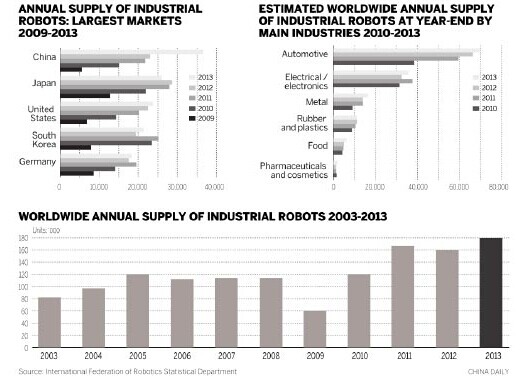

National Bureau of Statistics figures show an aging population is adding to the industrial tension. In 2012, China's working population was 937 million, 3.45 million less than in 2011, and last year, the number fell further to 920 million, accounting for about 67.6 percent of the entire population.
"The working population will continue to fall, so using robots has become an important tool to help companies maintain or improve their productivity," says Song, adding that robots are also better at doing repetitive, tedious and dangerous work.
The three-day Shanghai robot show last month attracted 216 companies from more than 18 countries and regions, as well as 38,572 visitors, a jump from last year's 27,371, showing the increased use of robots is capturing the public's imagination, too.
Shen Hongwen, deputy general manager of Yuzhou Yilan Copper and Aluminum Industry Co Ltd of Henan province, says his company plans to invest millions in robots this year.
"A worker's wage is about 3,000 yuan ($480) to 4,000 yuan a month, and is increasing.
"A robot that costs about 200,000 yuan is equally capable of doing the work of five workers, and that cost can be recovered in just one or two years."
As industrial China continues to transform and upgrade in search of better margins, the demand for robots is expected to rise, particularly in the country's manufacturing heartlands.
Traditional labor-intensive industries have been encouraged to diversify, or at the least operate in a more sustainable, environmentally friendly way.
"Industrial transformation means higher dependence on automation and precision, and the robot is the perfect tool for that," Song says. "The Chinese manufacturing sector has huge scale and diversity, much of which needs upgrading. That's why the market is growing so quickly."
Foxconn, the major supplier of components to Apple Inc in China, has vowed to use more robots in its manufacturing operations across the country, to replace dangerous, boring and repetitive work.
The company is building a research and manufacturing hub in Guiyang, the capital of Guizhou.
Terry Gou, its chairman, said last month that its operations in the city's new industrial park were expected to generate revenue of 50 billion yuan in 2018.
In 2011, Foxconn revealed it planned to be using a million robots in its factories within three years, and to have its factories fully automated within a decade.
Some top Chinese home appliance brands have also been employing robotic technology on a major scale.
Haier Group, the multinational electronics giant, is reported to have cut 18 percent of its workforce last year and will cut another 10,000 positions this year, due to its increased use of robots.
Midea, the privately held Chinese electrical appliance manufacturer, has also set up robot design and manufacturing teams, and already uses hundreds of robots on its production lines.
Noting the trend, the Chinese authorities have introduced policies to encourage more use of robotics.
In December, the Ministry of Industry and Information Technology issued guidelines for promoting the use of industrial robots.
And in June, at the 17th conference of the Chinese Academy of Sciences, the national institution conducting basic and applied research, President Xi Jinping stressed that "major robot manufacturers and countries are speeding up their market development, so our companies should also improve their robot-related skills".
In Qingdao, Shandong province, an industrial park has been set up dedicated to the robot sector. Opened in May of last year, it has attracted 30 companies and startups. Its target is 50 by 2016, generating output value of about 4 billion yuan.
"The robot industry is a way of promoting the whole city's industrial transformation and upgrade," says Geng Kai, deputy director of the Bureau of Investment Promotion at Qingdao National High-tech Industrial Development Zone.
"Qingdao has a good industrial foundation. Our machinery and equipment sector, which boasts many top appliance and food brands, had output exceeding 250 billion yuan last year. As a coastal city, we also have good natural conditions for developing marine-related robots that can work underwater."
Further south in Zhejiang province, known for exports largely dependent on low-cost labor, 36,000 local companies have stated that they plan to replace workers with machines by 2017, at a total investment expected to be more than 300 billion yuan.
Similar estimates have been published by officials in Guangdong province, the export manufacturing hub in the south of China, and in Jiangsu province, home to many of the world's leading exporters of electronic equipment, chemicals and textiles.
However, overseas-made robots still dominate. Of the 37,000 sold in China last year, only 9,000 were from Chinese suppliers. Local sales were three times higher than in the previous year, while the sales of foreign suppliers rose 20 percent, the China Robot Industry Alliance says.
But Japanese, European and US producers still accounted for the majority of major contracts, with Chinese products being targeted mostly at middle and low-end users.
"Robots made by Chinese suppliers still lag behind those made by international companies, in terms of quality, technical level and performance parameters," Song says.
Human-robot technology takes quantum leap
2014-07-26China Intl Robot Show kicks off in Shanghai
2014-07-10Guangzhou spurs robot use amid rising labor costs
2014-04-17Robot industry gets down to nuts and bolts
2014-04-02Shanghai‘s robot output at $3.2b by 2015
2014-03-28Goal for 3-5 strong robot firms by 2020
2013-12-31Copyright ©1999-2018
Chinanews.com. All rights reserved.
Reproduction in whole or in part without permission is prohibited.